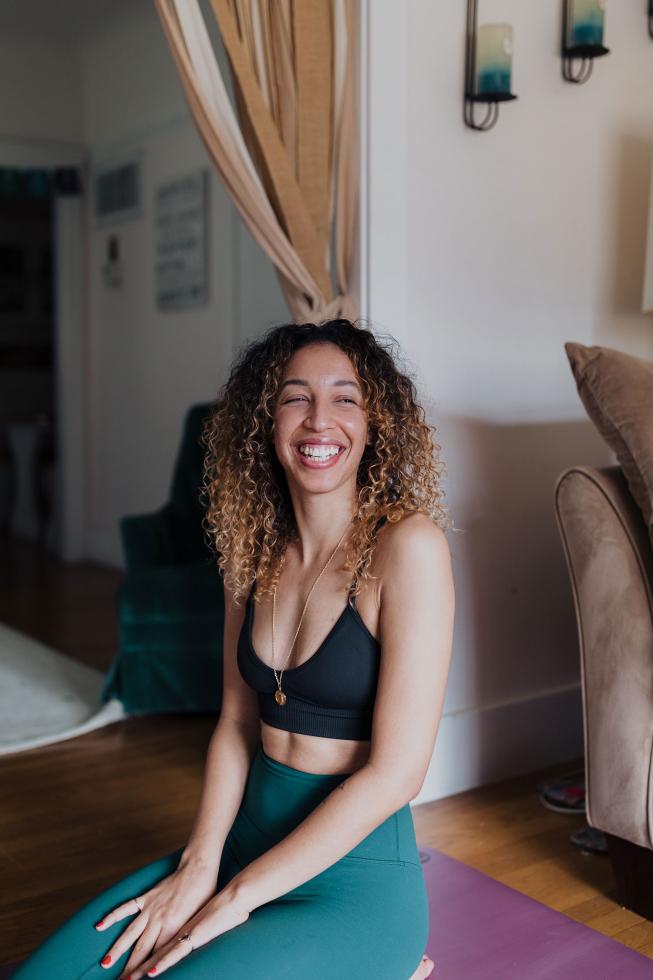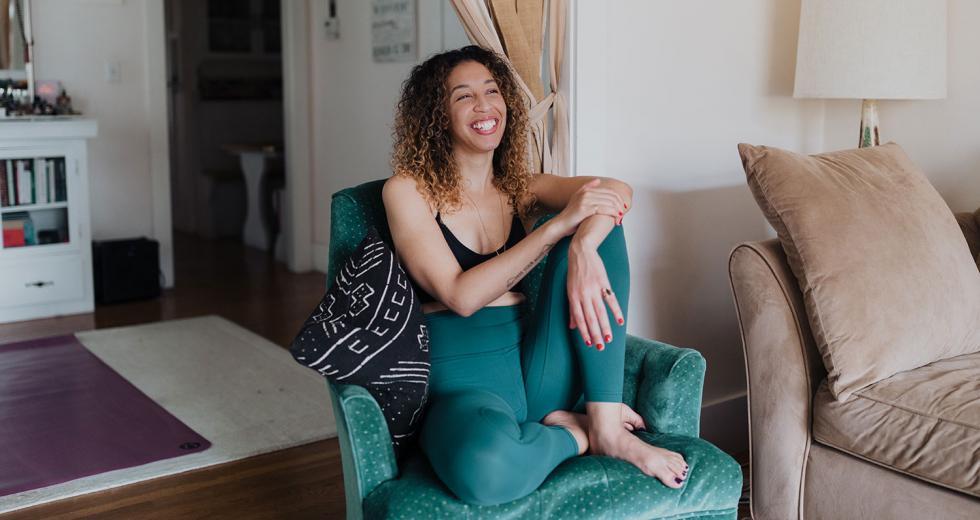The status quo is that yoga studios are usually white-owned establishments, and not much is done to make them more inclusive or representative of people of color. Angie Franklin, who is Spanish (born in Madrid, Spain) and black, was keenly aware of this fact and, two years ago, established Afro Yoga in Sacramento, to create a movement in the “for us, by us” model.
Seeing the need for people of color to be represented, to connect and to practice yoga in an inclusive environment, Franklin has created opportunities for people to engage through yoga classes, special events, workshops, mentorship programs, a podcast and an active social media presence. Afro Yoga connects people to themselves and others, all with Franklin’s “I keep it really real” communication style with her community.
The yoga teacher and activist discovered her calling in the most pedestrian of places: a surf camp in Portugal. She prefers yin yoga over vinyasa, shared values over dollar signs, and pop-up events over a brick-and-mortar studio. Read on for this yogi’s modern take on business.
How I describe Afro Yoga: I’ve always described it as a wellness movement. It’s not a studio, it’s not a style of yoga. It’s not necessarily a philosophy. It’s more about that social justice component within the wellness industry.
So what Afro Yoga really does is provide the opportunity for people to connect with themselves and to connect with others who have shared life experiences in environments that are safe and welcoming and loving and caring and nurturing and supportive. That’s really what I’ve come to realize that we offer — it’s not so much about the yoga or the guidance … it’s about getting people to connect with themselves and then offering that opportunity in spaces where they can see other people like them in this space. And that has been just monumental in what it does for the psyche, for the healing emotionally and mentally for people. So yeah, it’s all about getting people connected back with themselves.
Why I encourage people to do the work rather than self-medicate with feel-good outlets: In the Western, capitalistic society, and in social media and in our jobs, we’re often being asked to look outside of ourselves for answers, for validation, for love. I think our society really encourages us to look outside for everything that I feel we already have within. And I think the reason for that is that going within isn’t lucrative. … Because when you feel self-assured and when you’re good with you, you don’t necessarily need to buy another dress, or buy another eyeshadow palette, so you can feel pretty. Because you already feel beautiful from what you’re cultivating within.
I think (this philosophy) goes against the grain because the journey inward is also not one that always looks pretty. It can be very difficult. It can expose a lot of things to you about yourself that people aren’t always ready to confront. So there’s a lot of work that’s involved with that. And I think that looking outside of oneself for a quick fix or a shopper’s high or a comforting meal is really just a Bandaid. It’s easy to get caught up in that because of that instant gratification, that instant pleasure that we get from that. … I think the longer term satisfaction and real joy comes from working on what’s inside and making that a beautiful house to be in.
How I reach people with Afro Yoga: (Getting in touch with oneself) is a journey. My goal is to provide tools and resources for people to continue to work on their own when they’re not with us. So those things happen through online meditations and a community podcast. And on Wednesdays, I host an Instagram Live conversation. … We have sound healing yoga that we do with the Crocker Art Museum and one-off events that I do with different businesses in the community… I have a newsletter that goes out where I share different things with the community.
How I found the right path for me: I did a little bit of everything. From when I was 16, I worked at a hamburger joint, and then I worked at retail. I worked as an assistant to a real estate agent. I worked at a gym. I worked in email marketing. I worked at a bank for several years. I mean, I did all kinds of stuff. But what I found was always that after six months to a year, I’d become super disillusioned and unhappy with the job. It just wasn’t fulfilling for me anymore. And so I would quit or I would get fired …
So I didn’t really have a career path, and I think for a long time, myself — and maybe, secretly, my parents were like, what the hell is she going to do with her life? Because I would bounce around here and there, but I didn’t have a real hold on my passion or my purpose. So when I really got into yoga teaching, I knew for a fact that this was going to be my life.
How I found yoga: I was living overseas in Spain, just outside of Barcelona, and I got into a pretty deep depression. The things that I thought would work out didn’t. … I started practicing yoga again, from the little bit that I knew. … I ended up coming back to the states, and practicing yoga at a hot studio with a friend, and then just having a really interesting transcendental moment of just feeling really like a sense of pure bliss in the class.
A couple months later, a friend of mine told me that there was a yoga teacher training and that there was the opportunity for a scholarship. So I applied, and I got a 50 percent scholarship and attended the training… During a break in the training, I was like, I’m just gonna check out some jobs overseas and see what shows up. So I ended up finding this photography and yoga teaching job at a surf school in Portugal. And I was like, well, I’m just going to apply and see what happens, and they chose me. It was nuts, because I hadn’t even finished the training and I already had the first job abroad. I literally left three days after my yoga teacher training graduation and was in Portugal for three months teaching yoga at a surf school.
How I developed my distinct content style and my thoughts on branding: I am my own graphic and web designer in addition to the work I do with Afro Yoga. It started years ago when I started to do newsletters for my mom back in the day when she was running her business with essential oils. She was my first example of entrepreneurship, and I would go with her to events and seminars, so I designed some materials for all that stuff. I never really thought about it as, like, I’m a graphic designer. I was just doing this work ‘cause I’m creative and I can do it.
Angie Franklin established Afro Yoga in 2017.

I want to try to make it as easy to consume as possible for people and aesthetically pleasing so that people feel, you know, the warmth of that energy and feel invited to be a part of what we’re doing.
How I mix my real-life experiences with my digital influence to establish credibility and make connections: Most of it has been using Instagram. I enjoy the visuals of it, and it seemed to have the most engagement for me. The interesting part is that I always use Instagram to bring people off of the digital space into the real world.
Starting from a mentorship program, which is all online and virtual to the new series of online workshops that we just launched on Instagram Live — those are all things that have started almost two years deep into the work. So, I think for me, building community and building a reputation on the ground was my first and foremost goal to build trust with my community, and to allow the world to see those things in order to draw more people into the work that I was doing.
After having established the community on the ground and building the community online, it felt like an easier and more organic transition to doing (things like workshops) digitally, because I wanted to connect with the community that was virtual that we had built basically from the community that has been built on the ground. So it’s interesting how it works, and it’s been amazing to see the response.
And then showcasing those things on Instagram, for example, ended up attracting people from literally all over the world. They feel connected to our movement even if they are a whole other continent away. I had a woman who lives in London send me a (direct message) that she started a women-of-color yoga group because of the inspiration that she got from what we were doing.
The organizational item I can’t live without: Notes on my phone and to-do lists are critical for me. I use Evernote as well, which is like a glorified version of notes in your iPhone. That’s how I organize myself. It’s like a running to-do list where I get to see everything ahead of me for the week that I have to get done. It’s allowed me to feel like I had more control over it because it was actually down on paper (digitally speaking).
My thoughts on what makes for a strong business partnership or brand collaboration: If I’m collaborating with a business or organization, my first goal is to always just catch a vibe and ask the right questions. Like, what’s the mission of these people? What do they aim to do? What are they actually doing? Who works here? Is there diversity here? Is there inclusivity here? Is this a beautiful or inspiring space for people to be in? I think about all of those things.
An ideal partnership really looks like two people who are working to see the same thing happen, who are interested in the same type of person or people, and who have a sense of integrity about what they’re doing. Like that there’s a goodness behind it, and it’s not just about making money.
The genesis of collaborating with international fitness brand Lululemon: With someone like Lululemon, I definitely came in with eyebrows raised, you know what I mean? Because it’s seen as a very white brand, a very expensive, elitist white brand. I think that that is slowly changing because they’re doing the work and putting in the effort to try to be some of that change.
But what struck me was that they acknowledged that they were very white. They know that there’s an issue there, and they’re willing to put in the work to correct it. In addition to that, they’re willing to support people like myself, and have showed me nothing but full support from day one, even before I was an ambassador, to just support me in my community, in my work, and have been interested in it. And they’ve invited me to do racial justice trainings — myself and Corri Chadwick did stuff for their Northern California management team. So I think they’ve demonstrated that they’re sincere.
So, bottom line (for budding entrepreneurs), make sure that there’s some level of shared values and that whatever you’re exposing your community to is actually going to be beneficial for them and not just for you.



